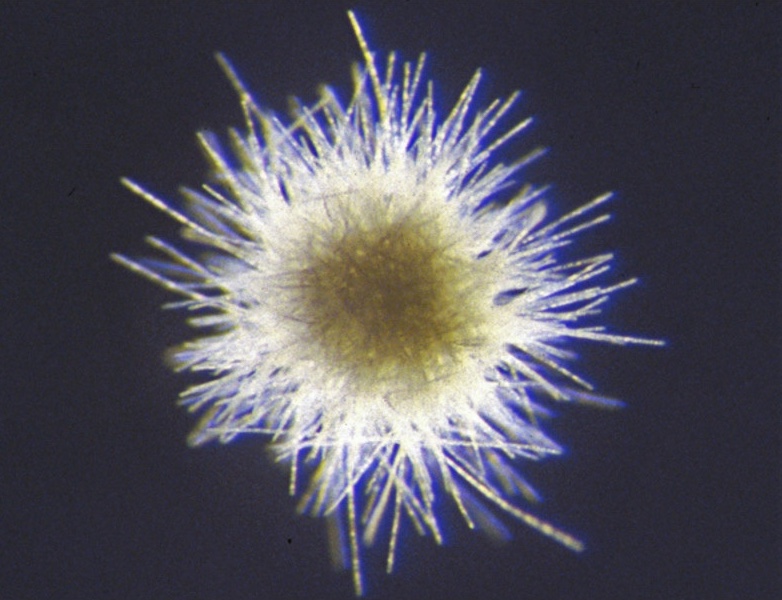van Kessel, M.A.H.J.; Speth, D.R.; Albertsen, M.; Nielsen, P.H.; Op den Camp, H.J.M.; Kartal, B.; Jetten, M.S.M., and Lücker, S. Complete nitrification by a single microorganism. Nature. 24/31 December 2015. doi:10.1038/nature16459.

Nitrogen is an essential element; without it there would be no DNA and no protein—ergo no life. Nitrogen makes up 78 percent of air, where it exists as dinitrogen (or N2), two atoms of nitrogen in a tight bundle inaccessible to plants and animals. Nonetheless, as sure as the grass, the trees, the bees, the cows, you, and I, Nature has its way of “fixing” nitrogen into biologically useful forms like ammonium (NH4+), nitrite (NO2–), and nitrate (NO3–). The biological nitrogen cycle (terrestrial and marine), which extracts nitrogen from that atmosphere and recycles it back, is driven by a network of prokaryotic microbes (bacteria and archaea) that use nitrogen in its various forms to charge their cellular batteries.
One key process in the nitrogen cycle is nitrification, a two-step process that consists first of the oxidation of ammonium to nitrite, followed by the oxidation of nitrite to nitrate (see feature image). The conventional wisdom on nitrification is that these two steps are performed by distinct bacterial species. However, complete ammonia oxidation (comammox) by a single bacterium is hypothetically possible, and could even be advantageous in certain resource-limiting environments (more energy for your nitrogen when the going gets tough)—so, why not?
“Why not comammox?” is precisely the question asked by a multinational team of scientists lead by Maartje van Kessel and Daan Speth, who, with a pinch of ingenuity and strong dose of patience, bring us the first two examples of comammox bacteria in a recent issue of Nature.
In their quest for comammox, Kessel and Speth et al., first needed a means of enriching for nitrifying bacteria. They did this by collecting the effluent of an aquarium circulating through an oxygen-free compartment (oxygen poisons nitrification) with a filter at the other end fine enough to capture bacteria. To farm nitrifying bacteria, they transferred the filtrate to a minimal growth medium containing low concentrations of the things nitrifying bacteria love most (ammonium, nitrate, nitrite, hold the oxygen). At long last, after a year of sampling in this manner, they obtained a microbial community which removed ammonium from the medium.
Using a technique that allowed them to visualize the species of bacteria growing in their nitrifying microbial community, van Kessel and Speth et al. identified that about half of their culture consisted of Brocadia bacteria, which are known to perform the process of anaerobic ammonium oxidation, which is the conversion of one molecule of ammonium and one molecule of nitrite to dinitrogen gas. Interestingly, a group of bacteria identified as Nitrospora that are usually associated with the oxidation of nitrite to nitrate formed a close association with the Brocadia, and made up about 15 percent of the culture. If this doesn’t sound off to you, it should, since both groups of bacteria require nitrite to perform their phylogenetically predicted functions. In other words, these bacteria should be competing with each other, but if they are competing with each other why are they found in a tight association more befitting of a cooperative relationship?
Intrigued by this very question, van Kessel and Speth et al. ground up their culture, and sequenced the the sum total DNA (also called the “meta-genome”) of the enrichment culture. Using computational techniques, they pulled out near complete genomes of the Nitrospora bacteria, and much to their amazement found that these two species contained the genetic potential encoded in a single genetic sentence (a sequential set of genes called an “operon”) to oxidize both ammonium and nitrite—in other words these bacteria looked an awful lot like the comammox bacteria of scientific lore!
To corroborate their genetic predictions, van Kessel and Speth et al. fed specially labeled ammonium to their culture that allowed them to track its fate, and provided experimental evidence for the genetically predicted comammox process. They further confirmed the ammonium-oxidizing activity of the comammox Nitrospora by using specific fluorescent probes to visualize ammonium-oxidizing enzymes in cells tagged as either species of Nitrospora.
To conclude their study, van Kessel and Speth et al. explored the environmental relevance of the newly discovered biological comammox process. Searching available sequence databases with the newly identified ammonium oxidizing genes, Kessel and Speth et al. unearthed previously overlooked bacterial species from environmental hotbeds of ammonium oxidation—wastewater treatment plants, soils, and sediments, hence demonstrating that comammox is more than a mere curiosity.
In revealing an entirely overlooked biological process in the nitrogen cycle central to life on Earth, van Kessel and Speth et al. demonstrate the importance of boldly questioning the status quo to further scientific knowledge. Prior to their finding, researchers dispelled the existence of commamox on the basis that probes for known ammonium oxidizing genes could not identify a bacterium with the full genetic potential to perform complete ammonium oxidation. By taking a step back and questioning textbook understanding, Kessel and Speth et al. made a groundbreaking contribution to an exhaustively studied biogeochemical cycle.
Abrahim is a PhD student at Scripps Institution of Oceanography in San Diego where he studies marine chemical biology.

